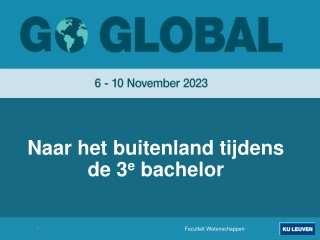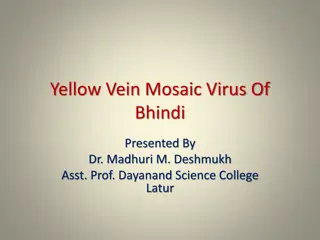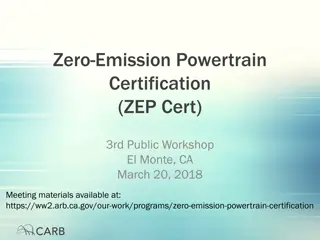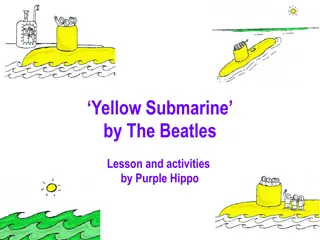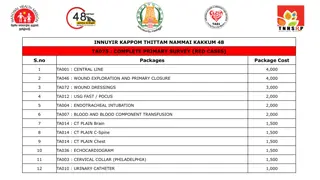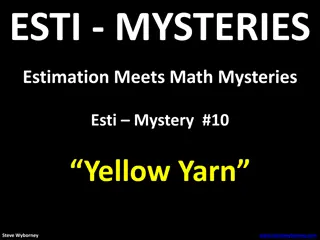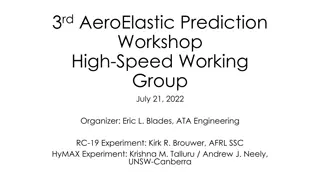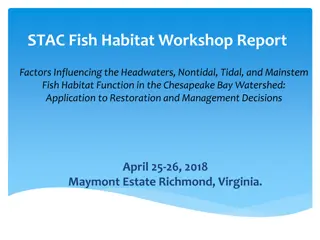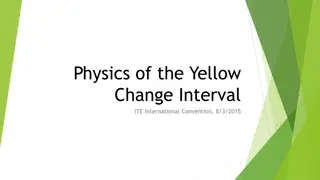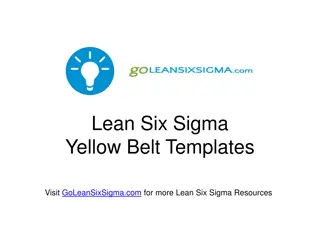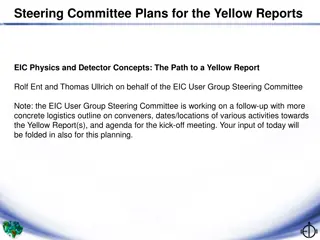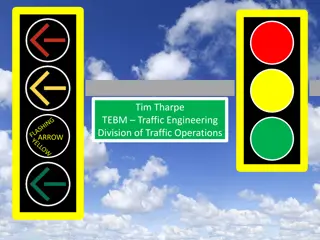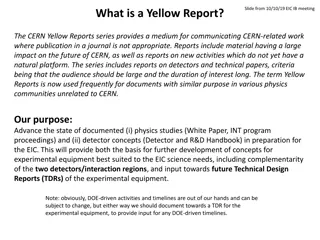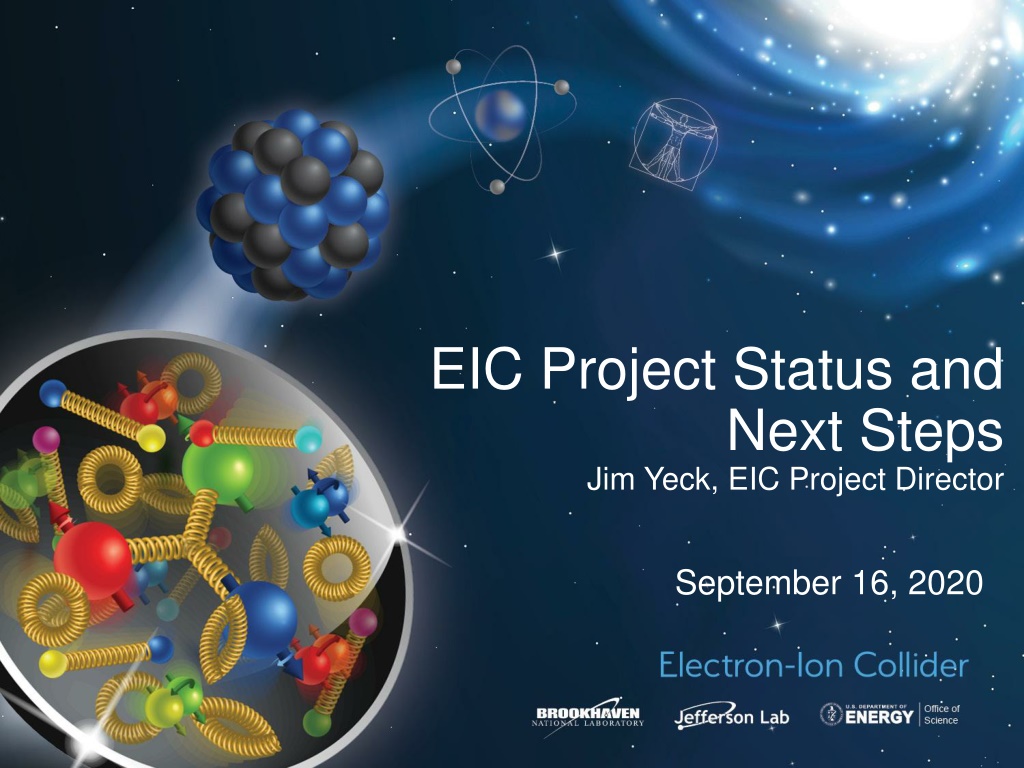
EIC Project Status and Future Plans
This report highlights the current status and future steps of the EIC project, led by Jim Yeck. It covers planning, recent history, scope details, funding profile, and progress within the organization, including partnerships and advisory committee meetings. Key milestones, such as site assessments and budget approvals, are outlined, along with target completion dates for different project phases.
Download Presentation

Please find below an Image/Link to download the presentation.
The content on the website is provided AS IS for your information and personal use only. It may not be sold, licensed, or shared on other websites without obtaining consent from the author. If you encounter any issues during the download, it is possible that the publisher has removed the file from their server.
You are allowed to download the files provided on this website for personal or commercial use, subject to the condition that they are used lawfully. All files are the property of their respective owners.
The content on the website is provided AS IS for your information and personal use only. It may not be sold, licensed, or shared on other websites without obtaining consent from the author.
E N D
Presentation Transcript
EIC Project Status and Next Steps Jim Yeck, EIC Project Director September 16, 2020
EIC Planning Context Performance and Scope Full-energy, full-luminosity accelerator (NSAC and NAS recommended) One interaction region with allowance for a second One detector Schedule Completion in ~10-15 years Cost CD-0 approved with a range of $1.6B-$2.6B 2
Recent History Event Date Mission Need Statement Approved January 22, 2019 Independent Cost Review (DOE Order 413.3b) July 2019 DOE Independent Electron Ion Collider Site Assessment October 8-9, 2019 CD-0 Approved December 19, 2019 DOE Site Selection Announced January 9, 2020 FY2020 Budget Includes EIC TEC and OPC Funding 1st Quarter FY2020 BNL TJNAF Partnership Agreement Approved May 2020 DOE OPA CD-1 Review Target Date January 26-28, 2021 2ndQuarter of FY2021 CD-1 Approval Target Date 3
Reference Funding Profile $1,973M Total Project Cost and Initial Operations in 2030 $350,000,000 $300,000,000 $250,000,000 $200,000,000 $150,000,000 $100,000,000 $50,000,000 $0 FY20 FY21 FY22 FY23 FY24 FY25 FY26 FY27 FY28 FY29 FY30 FY31 (US Fiscal Years) CD-1: March 2021 CD-2: September 2022 CD-3: September 2023 CD-4a: September 2030 CD-4: June 2032 Staged CD-4 Operations Start - CD-4a Install full RF Power - CD-4 $100M from New York State toward infrastructure 5
Progress on Organization BNL/TJNAF Partnership BNL and JLAB partnering agreement signed EIC Council established (BNL and TJNAF Directors) with a charter based on experience from recent projects including the LCLS-II and Exascale projects 1st meeting on June 25, 2020 Executive Management Team established BNL and TJNAF worked together to clarify mandates and membership for the advisory committees (project, machine, and detector) Machine Advisory Committee Meeting August 26, 2020 Project Advisory Committee Meeting August 27, 2020 Detector Advisory Committee Meeting September 28-29, 2020 Preparing for a Comprehensive Conceptual Design Review Jim Yeck and Allison Lung organizing the review in early November 2020 Co-chaired by Sarah Cousineau, ORNL, and Mark Reichanadter, SLAC retired 6
EIC Partnership Goals Prospects for significant international and domestic partners considered in planning the project Promoting a culture of interdisciplinary and multi-institutional collaboration for both the accelerator and experimental program Bi-lateral meetings with potential partners underway to discuss opportunities in the accelerator and experimental areas Accelerator Partnership Activities Workshop planned for October 7-9 Promoting Collaboration on the Electron-Ion Collider Possible contributions to the EIC accelerator could include the full range of accelerator design and hardware Detector Partnership Activities Call for Expressions of Interest (EoI) for potential cooperation on EIC experimental equipment was released in May: https://www.bnl.gov/eic/EOI.php. DOE Office of Nuclear Physics organizing regular meetings with international funding agencies 8
EIC Bilateral Discussions September 2020 SLAC EIC: ORNL EIC: TRIUMF EIC: CERN EIC: DESY EIC: ANL EIC: LBNL EIC: June August 2020 CERN FCC EIC: INF Krakow EIC: ANL EIC: CEA-Saclay EIC: 6/16 9/30 9/18 9/17 9/14 9/14 9/8 9/2 7/6 7/2 7/1 9
Experimental Program Preparations EIC Community s Yellow Report Initiative (Kickoff in December 2019, site) Four workshops planned to advance the state and detail of the documented physics studies and detector concepts in preparation for the realization of the EIC. BNL and TJNAF Jointly Leading Process for Defining Detector(s) Call for Potential Cooperation on the EIC Experimental Program published in May Includes two questionnaires, FAQ, and input received Expressions of Interest (EOIs) due November 1, 2020 Following the EOI Response Deadline Status report at 4th Yellow Report meeting in November Responses evaluated and Call for Proposal(s) finalized Assessment by Members of the Users Group and Project Management with advice from Detector Advisory Committee (DAC) Call for Detector Proposal(s) in March 2021 EIC EOI Site: https://www.bnl.gov/eic/EOI.php 10
2nd Detector and IR Planning EIC will be capable of supporting a science program that includes two detectors and two interaction regions EIC project planning includes ensuring the viability of a 2nd Interaction Region (IR) and detector EIC project budgets support construction of one IR and one detector Stakeholders agree that a 2nd IR and detector within the same timeline as the EIC project is desirable and routes to making this possible as a separate project will be explored Discussion and dedicated session(s) on the 2nd IR during Yellow Report Meeting in November 2020 Topical week-long workshop on 2nd IR concepts in February 2021 11
Detector Advisory Committee (DAC) First DAC Meeting is scheduled for September 28-29, 2020 DAC draft charter and agenda in discussion DAC members: Edward Kinney, CHAIR (University of Colorado) Etiennette Auffray (CERN) Peter Krizan (University of Ljubjana) Ana Ameila Machado (University of Campinas) Greg Rakness (Fermilab) Werner Riegler (CERN) Ewa Rondio (National Centre for Nuclear Research) Heidi Schellman (Oregeon State University) Brigette Vachon (McGill Univeristy) Andrew White (University of Texas at Arlington) Chi Yang (Shandong University) Glenn Young (BNL) Ex-officio members: Chair and Vice-chair of EICUGM Steering Committee Ex-officio members: Chair and Coordinator of Generic EIC Detector R&D program 12
Schedule 13
Timeline to CD-1 EIC Program Steering Group Meeting Partnership Agreement Signed Call for EoI for Contributions to Detectors EIC Director s Council Meeting Preliminary drafts/full outline of CDR due Draft CD-1 documents complete A/E Services Contract awarded Analysis of Alternatives Team report due Deadlines for drafts of new CDR material Freeze Design updates for Draft CDR Risk Workshop May 7, 2020 May 7, 2020 May 29, 2020 June 25, 2020 June 30, 2020 June 30, 2020 July 3, 2020 July 15, 2020 July 31, 2020 July 31, 2020 July 31-August 6, 2020 14
Timeline to CD-1 Freeze data for DOE Mini Review Independent Review of AoA CD-1 Documents complete for review AoA Final Report complete Mini MAC (Machine Advisory Com.) Mtg Post Material for DOE Status Review Project Advisory Committee Meeting Draft CDR complete DOE OPA Status Review Cost Estimate Scrubbing August 1, 2020 Week of August 10, 2020 August 15, 2020 August 25, 2020 August 26, 2020 August 26, 2020 August 27, 2020 September 1, 2020 September 9-10, 2020 Week of September 14, 2020 15
DOE Review September 9-11, 2020 20 External Reviewers, plus Observers Results Closeout Slides provided to EIC (53 slides) DOE CD-1 review scheduled for January 26-28, 2021 as originally planned Numerous constructive recommendations as is typical for these types of reviews Also constructive advice in the written comments and the discussions throughout the review EIC Team did a great job presenting documentation and plans! 16
Review Committee Participants OFFICE OF SCIENCE Kurt Fisher, DOE/SC, Chairperson SC1 SC2 SC3 Accelerator Systems Detector Infrastructure * Mark Champion, ORNL John Lewellen, LANL Tom Peterson, SLAC Philippe Piot, NIU Jie Wei, MSU * Reiner Kruecken, TRIUMF Andy Lankford, UCI Michelle Stancari, FNAL * Jeff Sims, SLAC Sam Paulsen, PNNL Jeff Pittman, PNNL SC4 SC5 SC6 Environment, Safety and Health * Ian Evans, SLAC Steve Trotter, ORNL Cost and Schedule Project Management * Kathleen Bailey, ANL Sherese Humphrey, ANL Ethan Merrill, DOE/OPA * Jim Kerby, ANL Angus Bampton, PNNL John Galayda, PPPL Hanley Lee, DOE/BASO Observers LEGEND Timothy Hallman, DOE/NP Jehanne Gillo, DOE/NP Manouchehr Farkhondeh, DOE/NP Ivan Graff, DOE/NP Joseph Eng, DOE/BHSO Joseph Diehl, DOE/BHSO SC Subcommittee * Chairperson Count: 21 (excluding observers) 17
OFFICE OF SCIENCE Charge Questions 1. Accelerator Conceptual Design: Is the present stage of the accelerator conceptual design sufficiently advanced to reach the technical maturity expected by the pre-CD-1 review planned for January of 2021? Is the overall concept technically sound and likely to meet the project s technical performance requirements? Is there an accelerator research and development (R&D) plan that adequately supports the design effort and mitigates the technical risks? 2. Experimental Program: Is the plan for defining the experimental program appropriate? Is there a detector R&D plan in place that will appropriately address the highest technical risks? Is the reference detector design sufficient to allow confidence in the detector cost estimate? 3. Conceptual Design Report (CDR): Is the CDR on track for timely completion for CD-1? 4. Project Scope: Is the project s scope sufficiently defined to support the preliminary cost and schedule estimates? 5. Cost and Schedule: Are the cost and schedule estimates credible and realistic for this stage of the project? Do they include adequate scope, cost, and schedule contingency that are based on a project-wide risk analysis? 6. Partnerships: Is the proposed distribution of scope between the EIC partners adequately understood for this stage of the project? Does the project have an appropriately defined framework to plan for the formalization of contributions from DOE and non-DOE partners? 7. Environment, Safety, and Health (ES&H): Is ES&H being properly addressed given the project s current stage of development? 8. Management: Is the project being properly managed at this stage? Has the management team made adequate progress on the prerequisite requirements for CD-1 approval and is there a sound plan for their completion? Will the project be ready for the pre-CD-1 review in January of 2021? 18
2.2 Detectors OFFICE OF SCIENCE R. Kruecken, TRIUMF / A. Lankford, UCI / M. Stancari, FNAL/ Subcommittee 2 2. Experimental Program: Is the plan for defining the experimental program appropriate? Yes, the experimental program is well defined, and a reference detector concept has been defined that is able to deliver the full science program. Is there a detector R&D plan in place that will appropriately address the highest technical risks Not yet. An explicit R&D plan is under development. OPC activities address high technical risks. Is the reference detector design sufficient to allow confidence in the detector cost estimate? Mostly. The reference detector design is an adequate basis for a reliable cost estimate. More work is required on the cost estimate. 3. Conceptual Design Report (CDR): Is the CDR on track for timely completion for CD-1? Yes. The Yellow Report will further inform the CDR. 19
CD-1 Review Final Preparations Detector Advisory Committee Meeting September 28-29, 2020 Accelerator Collaboration Workshop October 7-9, 2020 EOIs for Experimental Equipment Due November 1, 2020 Conceptual Design Review November 16-18, 2020 Project Advisory Committee Meeting November 19, 2020 NEPA Process Complete November 30, 2020 CD-1 Director s Review December 8-10, 2020 Conceptual Design Report Complete January 12, 2021 DOE CD-1 Review January 26-28, 2021 20
Post CD-1 Timeline Start Preliminary Design April 1, 2021 Focused Technical Reviews Spring 2021 DOE Status Review July 2021 DOE Status Review December 2021 Start Earned Value Tracking March 2022 CD-2 Director s Review March 2022 DOE CD-2 Review (Baseline) March 2022 Goal for CD-2 Approval September 2022 Goal for CD-3 Approval July 2023 21
Timeline Post CD-1 Start Preliminary Design Focused Technical Reviews OPA Status Review July 2021 OPA Status Review Start using EVMS as practice prior to CD-1 CD-2 Director s Review OPA CD-2 Review Goal for CD-2 Approval Goal for CD-3 Approval April 1, 2021 Spring 2021 December 2021 March 2022 March 2022 June 2022 September 2022 July 2023 22
EIC Challenges and Opportunities Affordability EIC is very large project for DOE Office of Nuclear Physics (NP) and Office of Science (SC) Requires reprioritization of RHIC operations funding to EIC and new funding Significant ramp up of project funding (annual doubling) starting in FY2021 is required to maintain timeline for Critical Decisions Most cost-effective project follows closely to a technically driven schedule Partner Engagement Expectations and Implementation International and domestic engagement highly desirable and widely expected In-kind contributions to the accelerator and experiment(s) will be pursued Potential partners must be engaged now given the EIC technically driven schedule 23
EIC Challenges and Opportunities JLAB Partnership Non-traditional, breaking new ground EIC Executive Management Team (Level 1) and JLAB personnel in Level 2 management roles establish JLAB as a full intellectual partner in the leadership of the project. BNL and JLab jointly hosting the EIC experiments. JLab responsibilities for project scope need to be further clarified COVID-19 Impacts Immediate and long-term implications Current EIC activities are primarily planning and design work carried out remotely There are impacts on efficiency and R&D work, however we remain confident about the path to CD-1 Indirect impacts will likely to be more significant, including aligning with RHIC operations plans, uncertain fiscal context, design efficiency, R&D efficiency 24
Summary Overall Project Delivery Plans Rapidly Maturing Strong foundation in place: pre-conceptual design, cost and schedule Pursuing broad collaboration around the EIC BNL and JLAB leadership and the entire EIC Project Team committed to delivering the EIC project as cost effectively as possible and with the engagement of partners Project planning has matured to level required for DOE CD-1, with a clear timeline of activities to be completed prior to DOE OPA CD-1 review Schedule aligned with reasonable annual funding projections DOE review and approval process established: CD-1 approval in March 2021 Experimental Program Planning BNL and TJNAF jointly leading the process for defining detector(s) Community engagement and timeline for the Yellow Book, Call for Expressions of Interest, Call for Proposals, etc. is extremely important BNL and TJNAF jointly serve as the host lab for the international user community - EIC Call for Expressions of Interest (EoI) released: https://www.bnl.gov/eic/EOI.php. Detector(s) plans will align with project CD-4 schedule and transition to operations 25

